
Hao ground (1960-), Shanxi Liulin, professors, engaged in teaching and research work of Municipal and Environmental Engineering, the main research directions for sewage biological nitrogen removal in addition to phosphorus techniques; mathematical simulation of sewage treatment technology; sustainable environmental biotechnology, He is currently the editor-in-chief of the Water Research Journal of the International Water Association.
The progress of sewage treatment towards carbon neutral operation has already become the future development direction of sewage treatment in Europe and the United States. If the carbon neutral operation is targeted, the excess sludge will obviously no longer be the “burden†of sewage treatment, and will become a hot material for carbon neutral operation. To this end, the sewage treatment industry no longer needs to blindly pursue sludge reduction, and instead expects sludge to increase, in order to increase the self-sufficient raw material share of sewage treatment energy.
However, the amount of excess sludge depends entirely on the level of influent COD load. A low COD load will inevitably lead to less excess sludge production, which means that there may be a deficit in carbon neutral operating energy demand. Therefore, the increase of sludge targeting carbon neutralization has quietly emerged in the world in recent years. In addition to conventional excess sludge, it will seek sludge increments from other sources, such as front-end screens. Divided into COD technology, back-end anaerobic co-digestion technology.
Status of foreign surplus sludge energy conversion
Sewage treatment carbon neutralization operation to achieve energy self-sufficiency in the entire sewage treatment process, in order to achieve this goal, Europe and the United States, and even some surrounding Asian countries have successively issued a road map for the 21st century sewage treatment carbon neutralization operation, and put into practice. E.g:
As early as 2008, the Netherlands proposed the concept of wastewater treatment NEWs, describing the future sewage treatment plant as “Nuttrientâ€, “Energy†and “Renewable Water†(Factories). Operating mode.

The “Carbon-free Water†promoted by the United States is expected to achieve carbon neutrality in the whole process of water extraction, distribution, treatment and discharge.

The Japanese authorities issued the “Sewerage Vision 2100â€, stating that by the end of the century, the sewage treatment energy will be fully self-sufficient.

Sewage Sludge to Provide Electricity for Households and Hydrogen to Power Vehicles
At present, some sewage treatment plants in Europe and the United States use excess sludge as the main energy carrier, combined with front-end screening COD (influent COD load high) technology, or back-end anaerobic co-digestion (food waste, food processing waste, feces) Technology) to obtain energy (CH4) from sewage or exogenous organic matter by anaerobic digestion in a manner that maximizes “sludge increment†and has fully or partially achieved carbon neutrality operational targets.
Sludge energy conversion carbon neutralization potential
Some sewage treatment plants that implement carbon neutrality operation targets in countries such as Europe and the United States are mostly based on anaerobic digestion and conversion of energy from surplus sludge. Countries such as Europe often have higher influent COD concentrations (600~1 000 mg/L) due to lifestyle habits, no septic tanks, rain and sewage diversion, and food breakage. Some examples of wastewater treatment in Europe and the United States with carbon neutrality indicate that if the influent COD is 600 mg/L, the amount of excess sludge produced by conventional treatment processes (such as A2/O denitrification and dephosphorization process) is passed. Anaerobic digestion and conversion energy is difficult to fully meet (100%) carbon neutral operation targets, generally achieving 70% carbon neutralization rate is sufficient.
The content of organic matter in sewage in China is much lower than that in Europe and the United States, so it is difficult to achieve the carbon neutralization target only by the surplus sludge generated. Figure 1 plots the COD rejection of the excess sludge (primary and secondary sedimentation) in the energy balance calculation (the ratio of total COD to influent COD in the sludge) versus carbon neutralization. The trend in Figure 1 shows that more sludge neutralization is required to achieve greater carbon neutrality, ie the so-called “sludge incremental†concept. From the perspective of the source of COD, the increase of sludge means that the COD in the influent should avoid the direct oxidation of COD without purpose, in addition to the demand for carbon source for nitrogen and phosphorus removal.

Figure 1 Relationship between sludge COD rejection and carbon neutralization rate
Sludge increment method and measure
A/B method A section concentrated COD
As early as 15 years ago, in collaboration with Professor Mark van Loosdrecht of TU Delft, a sustainable municipal wastewater treatment centered on energy and phosphorus recovery, we proposed the conceptual process shown in Figure 2. . In order to effectively intercept the excess COD (except the carbon source required for nitrogen and phosphorus removal) and convert it to methane by anaerobic digestion, the A section of the German A/B method was used to concentrate the suspended and dissolved COD. Compared with the second sedimentation sludge, the intercepted sludge in section A has better digestibility and can produce biogas with higher methane content.

Figure 2 Municipal wastewater treatment concept process located in energy and phosphorus recovery
Front-end screening COD technology
In order to maximize the retention of COD in the influent, European scholars have also proposed to use the microfiltration method after flocculation to intercept the colloidal and dissolved COD, and use it for anaerobic digestion to convert methane into action. For example, a water company in Berlin, Germany, and the German KWB organization have launched an application research project for the recovery of energy in wastewater – CARRISMO (carbon is money), the process flow is shown in Figure 3.

Figure 3 German CARISMO front-end COD screening and subsequent sewage and sludge treatment process
Sludge co-digestion technology
The co-digestion of sludge exerts a synergistic effect between the substrates, which improves the degradation rate and degradation degree of the substrate, and the energy conversion efficiency is significantly improved. Table 1 lists the energy conversion effects of several different exogenous organic wastes and residual sludge, and the co-digestion potential of excess sludge and other organic wastes is evident.
Table 1 Different types/proportions of exogenous matrix and sludge co-digestion energy conversion effect

If the kitchen waste, green grass, dry toilet waste and excess sludge can be co-digested together in the future, there will be a situation in which more than two kinds of substrates are co-digested. In research and application practice, three kinds of organic substrate co-digestion cases are still very rare. This topic should be the research and development direction of anaerobic co-digestion in the future, not only to explore the mechanism and role of multi-substrate synergistic digestion, but also to open up a sustainable development path for comprehensive disposal of municipal organic solid waste.
From a technical point of view, there is no obstacle to the carbon neutralization operation of sewage treatment, which is mainly limited by the government's macro environmental policy. As long as the government is far-sighted, policy support and even financial subsidies will touch the sewage treatment industry toward carbon neutrality, thus gaining comprehensive environmental benefits that are generally optimistic.
The trends of the Copper recycling industry
Manufacturers in the recycled copper market are sourcing their metals from discarded automotive components, construction materials, electronic devices. Such developmental activities are contributing toward the growth of the global market, which is predicted to advance at a modest CAGR of 3.5%, in terms of volume, throughout the assessment period.
Recycling companies are upgrading their technology and equipment to meet high copper consumption in the World.
Scrap copper collected from various sources is used as raw material in copper recycling, scrap copper metal is separated and processed several times to yield recycled copper.
The Scrap Copper Metal Baler machine makes your copper recycling more efficient and profitable.
Through the process of baling, save the cost of storage and transportation of waste, improve the melting efficiency of the furnace and so on.
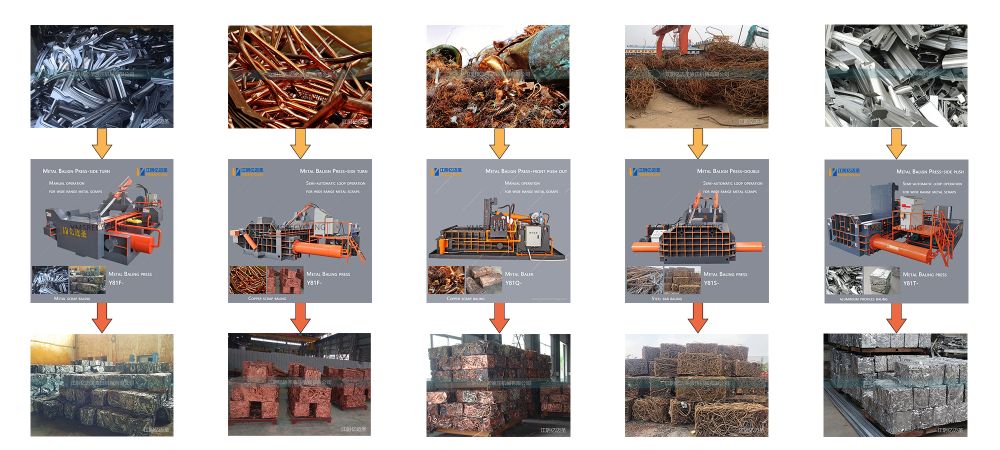
The Y81 series Scrap Copper Metal Baler could not only press all non-ferrous metals such as copper, brass, and aluminium can be recycled as well as ferrous metals from steel to stainless steel, with various sizes for option, high-density compression, compact and strong. Low energy consumption but fast production rate.
Y81 series hydraulic metal baler mainly include the following models.
Y81F (side turn discharge ), Y81T (side push discharge), Y81Q (front push discharge) and Y81S (Double main press ).
We also support the design and manufacture of other model versions upon request.
Y81Q-Manual operation (Front push discharge )
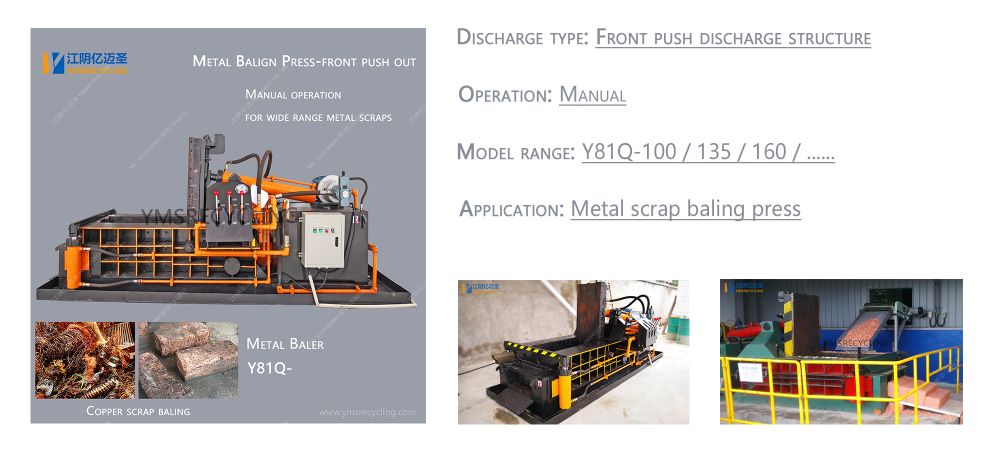
Y81F-Manual operation (Side turn discharge )
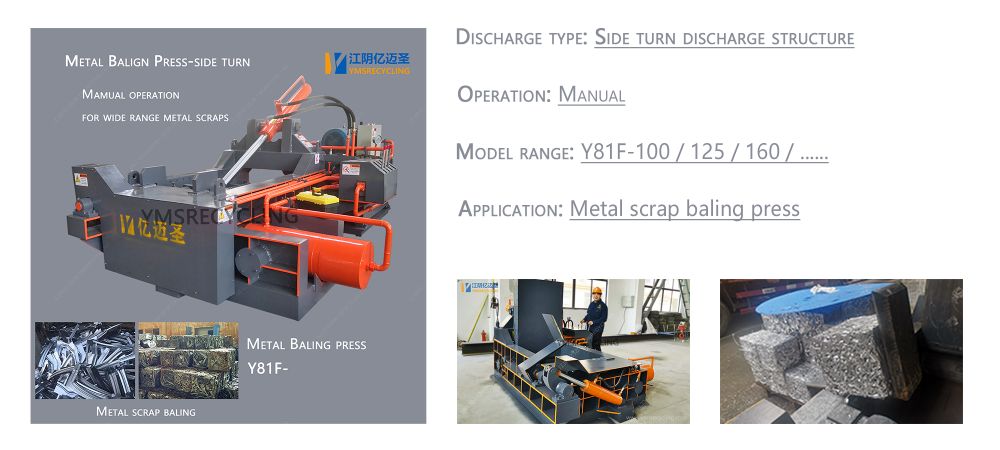
Y81F-Semi-automatic operation (Side turn discharge )
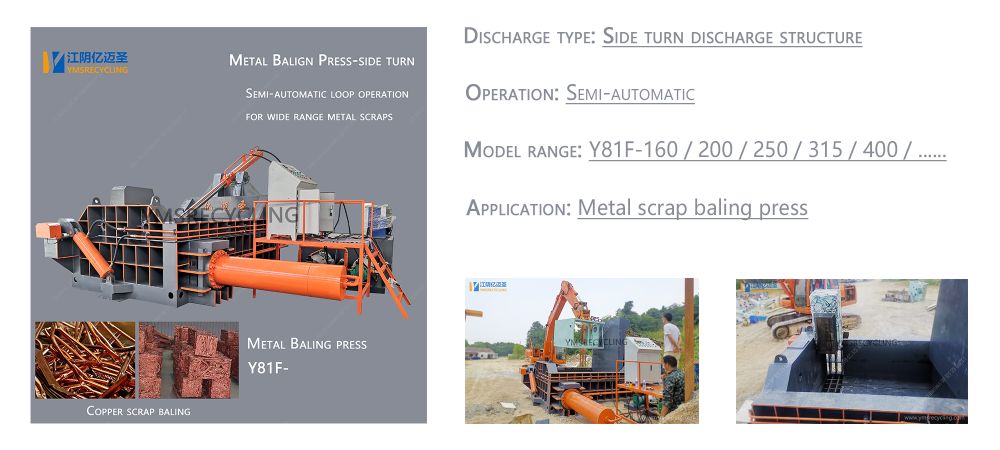
Y81T-Semi-automatic operation (Side push discharge )
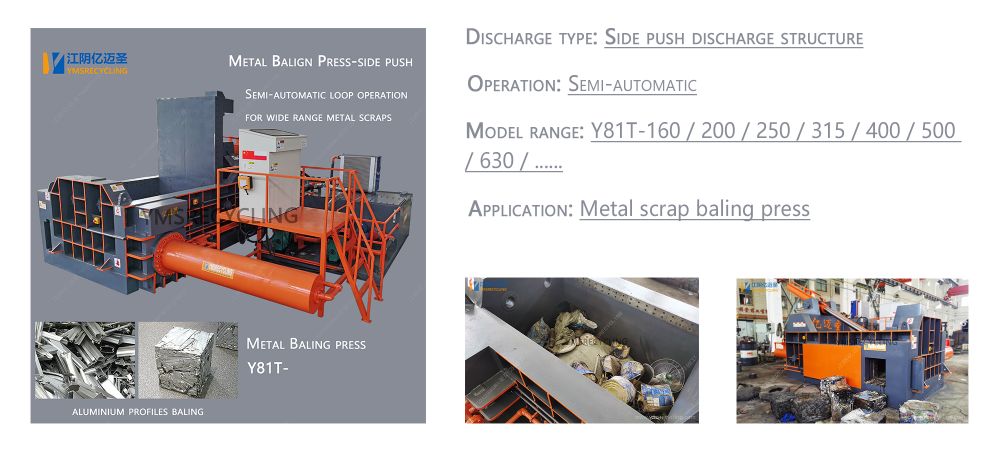
Y81S-Semi-automatic operation (Double main press discharge )
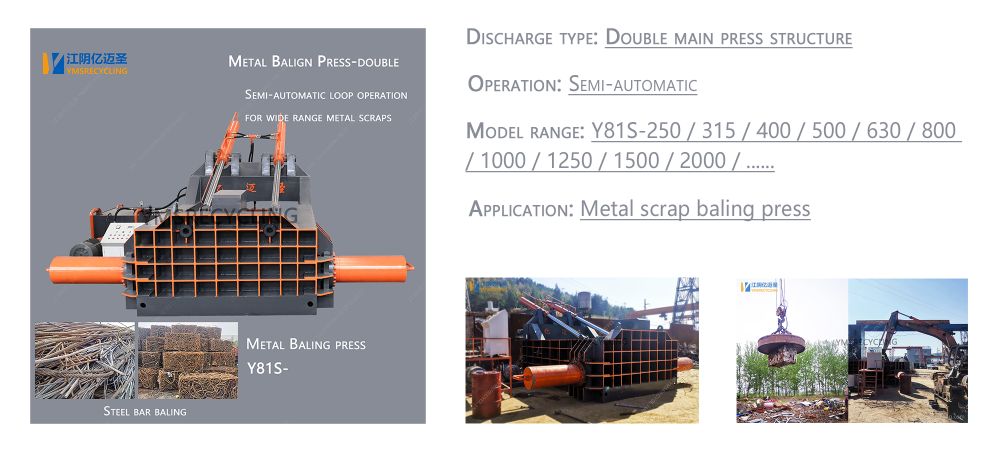
We provide a variety of models of the hydraulic metal baler, With new technologies to raise the quality and reduce the price, which supports 24 hours fully automatic working environment.
YMSRECYCLING offer economical and effective solutions to help you to process different metal scraps.
The Metal Baling Press can be customized and extended according to the actual needs of your on-site.
CONTACT YMSRECYCLING
Call us now on +86-15950122559
To start maximising your returns from your metal scrap recycling.
Please email sales@ymsrecycling.com or visit our website directly for further information about the products you are interested in.
Copper Baler,Copper Metal Baler Machine,Scrap Copper Metal Baler,Hydraulic Copper Scrap Baler
Jiangyin Yimaisheng Hydraulic Machinery Co., Ltd. , https://www.ymsrecycling.com